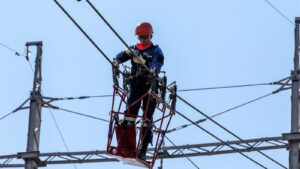
The Ukrainian Cabinet of Ministers has simplified procedures for restoring elements of the gas transportation system and power lines, the Ministry of Energy announced on Monday.
“This will enable companies to implement projects for the construction and reconstruction of gas transportation system components, in particular special bridges for reverse gas supplies, more quickly,” the ministry explained.
In addition, conditions for the construction of new power lines will be simplified, especially in frontline regions, to ensure rapid restoration and reliable electricity supply to consumers.
“The government has adopted a strategic decision aimed at strengthening the sustainability of Ukraine’s energy system in preparation for the autumn-winter period. This step will allow for the rapid restoration of power lines damaged by the war and the construction of new ones, especially in frontline areas,” said Energy Minister Svetlana Grinchuk.
According to her, this decision will also significantly reduce the time needed to prepare and implement technical solutions aimed at strengthening the reliability and flexibility of the natural gas transportation system.
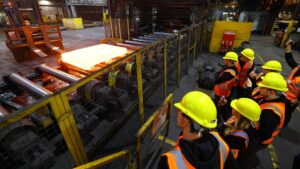
In 2024, the Metinvest mining and metallurgical group reduced its rolled steel production in the UK and the EU by 13% to 1.367 million tons, which was caused by unfavorable market conditions in the EU, in particular the availability of cheap Russian slab, according to the group’s annual report.
According to the report, flat steel production at Metinvest Trametal decreased by 3% to 466,000 tons, at Ferreira Valsider by 45% to 190,000 tons, and at Spartan UK by 22% to 153,000 tons.
Overall, Trametal accounted for 34% of total production in the UK and the EU last year (31% in 2023), Ferreira Valsider for 14% (22%), Promet Steel for 41% (35%), and Spartan for 11% (12%).
As reported, in 2024, Metinvest reduced sales of finished metallurgical products by 5% compared to the previous year, semi-finished products by 3%, but increased coke sales by 6%, and sales of other products and services increased by 33%.
Revenue from the metallurgical segment remained virtually unchanged compared to 2023 and amounted to $4.824 billion, while the segment’s share in consolidated revenue decreased by 6 percentage points (pp) to 60%.
At the same time, sales of merchantable pig iron decreased by 15% to $266 million due to a 16% reduction in shipments to 558 thousand tons. In particular, the reduction in resales and production volumes of the group amounted to 12% and 52%, respectively. The share of resales in total sales increased by 4 p.p. to 95%. North America and Europe remained the main markets for this product. They accounted for 71% and 23% of total shipments last year, compared with 70% and 26% in 2023.
Sales of semi-finished products increased by 9% last year to $389 million, thanks to a 16% increase in sales volumes to 716,000 tons amid a reduction in inventories. Shipments to the Middle East and North Africa (MENA) increased by 237,000 tons, accounting for 50% of total shipments in 2024 (20% in 2023). In contrast, shipments to Europe decreased by 143,000 tons and accounted for 38% of total sales (68% in 2023). The average selling price declined in line with the dynamics of CFR Turkey square billet prices (down 7% compared to 2023).
In 2024, flat steel sales declined by 6% to $2.244 billion. This was due to lower sales prices following the dynamics of the corresponding benchmark for hot-rolled coils CFR Italy, which fell by 9%. Total shipments increased by 7% to 3.047 million tons, driven by a 26% increase in resales to 2.111 million tons, which increased their share in total shipments to 69% (up 10 percentage points). Deliveries were primarily to Europe, which accounted for 72% of the total (71% in 2023). Sales in the region increased by 193,000 tons thanks to demand from key customers, expansion of the customer base, and stable operations at Black Sea ports. Domestic sales accounted for 23% of sales (25% in 2023).
Sales of long products remained unchanged in 2024 at $948 million. Shipments increased by 5% to 1.372 million tons, primarily due to higher production volumes at Kametstal. Ukraine and Europe remained the main markets for these products. They accounted for 45% and 35% of total sales, respectively, compared with 48% and 39% in 2023. The Group increased its shipments to North America, which accounted for 17% of total sales in 2024, compared with 12% a year ago. Average sales prices declined in line with the benchmark for CFR Turkey square billets.
The report notes that in 2024, Metinvest achieved significant results from operational improvements. In particular, in the metallurgical segment, coke consumption at Kametstal was reduced and blast furnace productivity was improved thanks to the rapid adaptation of pulverized coal injection technology to alternative types of coal under military supply restrictions. In addition, the optimization of raw material procurement contributed to the positive results.
Metinvest is a vertically integrated group of mining and metallurgical companies. Its enterprises are located in Ukraine, in the Donetsk, Luhansk, Zaporizhia, and Dnipropetrovsk regions, as well as in the European Union, the United Kingdom, and the United States. The main shareholders of the holding company are SCM Group (71.24%) and Smart Holding (23.76%). Metinvest Holding LLC is the management company of the Metinvest Group.
EU, METINVEST, PRODUCTION, rolling, UK
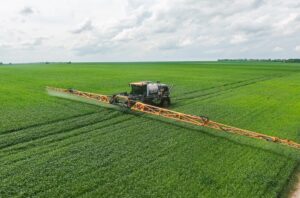
The TAS Agro agricultural holding has begun sowing winter crops for the 2026 harvest, starting with winter rapeseed in the fields of the Central Cluster in the Kyiv region, the company’s press service reported on Facebook.
“In accordance with the company’s crop rotation strategy, a total of 16,000 hectares are planned to be sown with winter rapeseed,” the agricultural holding said.
Agrotrade specified that sowing is carried out with the simultaneous application of complex fertilizers using Strip-till technology, which will allow for high-quality and friendly germination in case of moisture deficiency.
The Agrotrade group of companies is a vertically integrated holding company with a full agricultural cycle (production, processing, storage, and trade of agricultural products). It cultivates over 70,000 hectares of land in the Chernihiv, Sumy, Poltava, and Kharkiv regions. Its main crops are sunflower, corn, winter wheat, soybeans, and rapeseed. It has its own network of elevators with a total storage capacity of 570,000 tons.
The group also produces hybrid seeds of corn, sunflower, barley, and winter wheat. In 2014, a seed plant with a capacity of 20,000 tons of seeds per year was built on the basis of the Kolos seed farm (Kharkiv region). In 2018, Agrotrade launched its own brand, Agroseeds.
The founder of Agrotrade is Vsevolod Kozhemyako.

Metinvest B.V. (Netherlands), the parent company of the mining and metallurgical group Metinvest, increased its EBITDA by 11% in 2024 compared to 2023, to $957 million, according to updated data published in its annual report.
According to the report, EBITDA in the metallurgical segment grew by 82% to $289 million, while in the mining segment it remained unchanged at $768 million.
At the same time, it is specified that last year, corporate overhead costs and eliminations amounted to $100 million (in 2023 – $68 million). As a result, in 2024, the mining segment’s share in the group’s EBITDA (excluding corporate overhead costs and eliminations) was 73% compared to 83% in 2023, while the metallurgical segment’s share last year increased to 27% compared to 17% in the previous year.
The growth in the group’s EBITDA was primarily due to an increase in sales of own iron ore products, as well as billets and long products, operational improvements, the positive impact of the hryvnia’s depreciation against the US dollar on costs, increased efficiency at both joint ventures, lower raw material costs due to lower prices for coal, coke, and iron ore, and reduced purchases of third-party raw materials for rolling mills.
These factors were partially offset by lower sales prices, higher overall logistics costs, primarily due to increased sea shipments from Ukraine to distant markets, and higher energy costs, primarily due to higher electricity costs.
In 2024, the Group’s EBITDA margin was 12% (unchanged from 2023). The EBITDA margin of the mining segment was 20% (down 6 percentage points (pp) compared to 2023), while the EBITDA margin of the metallurgical segment was 6% (up 3 pp).
In 2024, net cash used in investing activities amounted to $197 million, down 34% from 2023. The total amount of cash used to acquire property, plant, and equipment and intangible assets decreased by 29% to $216 million. Interest income doubled to $13 million, while proceeds from the sale of property, plant, and equipment and intangible assets decreased slightly to $6 million.
In 2024, net cash used in financing activities amounted to $241 million, compared to $115 million in 2023. Net repayment of loans and borrowings amounted to $216 million (in 2023 – $185 million), mainly due to bond redemptions. Net trade financing amounted to $25 million, compared to $70 million a year ago.
In 2024, Metinvest adhered to a fairly balanced investment policy, dictated by wartime restrictions in Ukraine and the need to decarbonize the European steel industry. Investments in Ukraine were primarily directed toward employee safety, ensuring the availability and operation of critical equipment, strengthening energy resilience, and complying with environmental standards at the companies.
In addition, particular attention was paid to resolving logistical issues. Although most large strategic projects remained frozen, Metinvest launched a new project to concentrate enrichment waste at the Northern GOK. It aims to reduce waste volumes, lower operating and capital expenditures, and minimize environmental impact while maintaining production volumes.
At the same time, the group is also preparing for the country’s post-war recovery. Outside Ukraine, Metinvest is working on the Adria project to build a low-carbon steel plant in Italy.
The group’s total capital expenditures decreased by 17% to $235 million. Approximately 83% of this amount was allocated to maintenance projects and 17% to strategic projects.
Metinvest increased the capacity utilization of most of its enterprises. This was an important achievement for the group, given the prolonged impact of the war. The resumption of shipping in the Black Sea played a decisive role in our work. This ensured a reliable export route and allowed us to increase delivery volumes. At the same time, significant challenges remained. Throughout the year, power outages had a negative impact on profitability. In addition, despite incredible resilience throughout most of the year, the approaching front line forced us to gradually suspend operations at the Pokrovsk Coal Group,” said Yuriy Ryzhenkov, CEO of the group, in the report.
As reported, Metinvest’s consolidated net loss in 2024 increased sixfold compared to 2023, to $1.152 billion from $194 million, while revenue rose to $8.050 billion from $7.397 billion.
Metinvest is a vertically integrated group of mining and metallurgical companies. Its enterprises are located in Ukraine, in the Donetsk, Luhansk, Zaporizhia, and Dnipropetrovsk regions, as well as in the European Union, the United Kingdom, and the United States. The main shareholders of the holding company are the SCM Group (71.24%) and Smart Holding (23.76%). Metinvest Holding LLC is the managing company of the Metinvest Group.
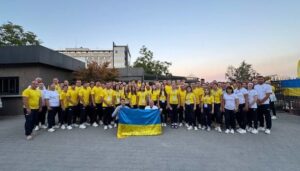
The Ukrainian team won 23 medals (5 gold, 8 silver, and 10 bronze) and took 10th place in the overall standings at the 2025 European Youth Olympic Festival, which took place in Skopje (North Macedonia).
“This is Ukraine’s second most successful performance in the history of its participation in the Festivals since 1993! The blue and yellow team won more medals only in 2019, when it won 25 awards (8 gold, 7 silver, and 10 bronze),” the National Olympic Committee reported on its Telegram channel on Sunday.
A total of 78 young athletes in 12 sports represented Ukraine at the EYOF 2025. “This year, Ukrainians climbed the podium in seven sports. Judo: 2 gold, 1 silver, 3 bronze. Swimming: 2 gold, 2 silver, 1 bronze. Athletics: 1 gold, 1 silver, 2 bronze. Taekwondo: 2 silver, 1 bronze. Shooting: 1 silver, 1 bronze. Artistic gymnastics: 1 silver, 1 bronze. Table tennis: 1 bronze,” the report said.
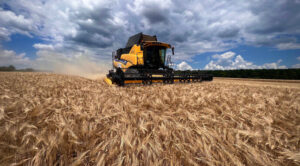
Agroholding Agrotrade has already threshed over 2,500 hectares, which is 14% of the total plan for early crops, with the largest areas processed in the Kharkiv and Sumy regions, the agroholding’s press service reported on Facebook.
Agrotrade reminded that in the 2025 season, winter wheat accounts for 85% of the harvest structure, and winter rapeseed accounts for 15%.
“In the Kharkiv region, winter wheat yields have been reduced due to frosts, but the Sumy and Chernihiv regions are gradually evening out the overall picture. We started harvesting on drier plots and expect higher yields on later varieties. Overall, we expect to meet the plan with a slight overrun. Winter rapeseed yields average about 3.5 tons per hectare — despite the weather, the results are in line with expectations,” said Oleksandr Ovsyanyk, director of the agro-industrial department at Agrotrade.
According to him, the best results are in Chernihiv region, where rapeseed yields are 111% of the plan, and in Kharkiv region, where winter wheat yields in some fields are over 5.4 tons/ha, so the plan is being met at 106%.
The Agrotrade Group is a vertically integrated holding company covering the entire agricultural cycle (production, processing, storage, and trade of agricultural products). It cultivates over 70,000 hectares of land in the Chernihiv, Sumy, Poltava, and Kharkiv regions. Its main crops are sunflower, corn, winter wheat, soybeans, and rapeseed. It has its own network of elevators with a total storage capacity of 570,000 tons.
The group also produces hybrid seeds of corn, sunflower, barley, and winter wheat. In 2014, a seed plant with a capacity of 20,000 tons of seeds per year was built on the basis of the Kolos seed farm (Kharkiv region). In 2018, Agrotrade launched its own brand, Agroseeds.
The founder of Agrotrade is Vsevolod Kozhemyako.